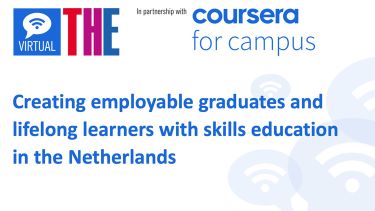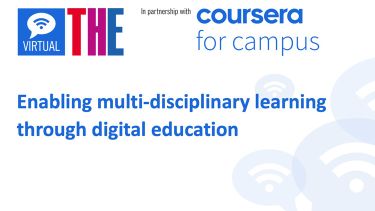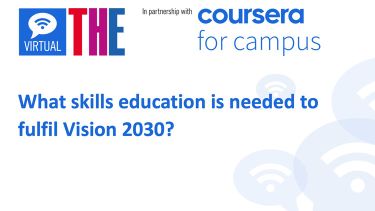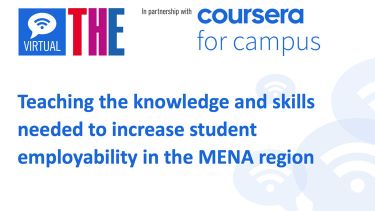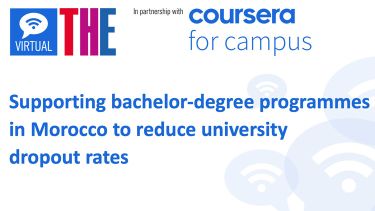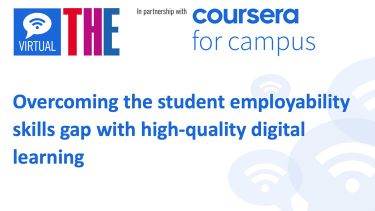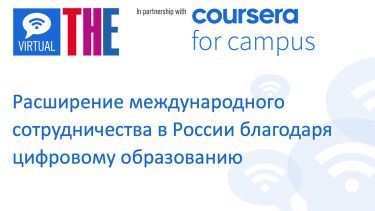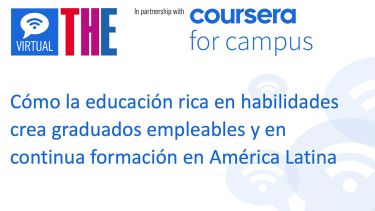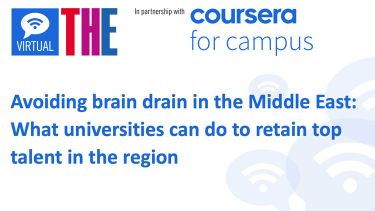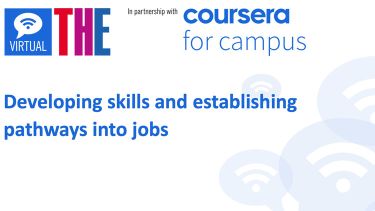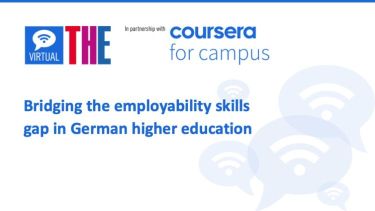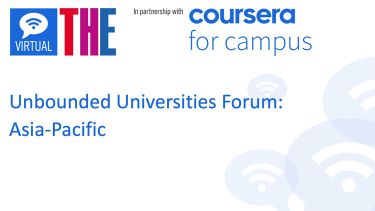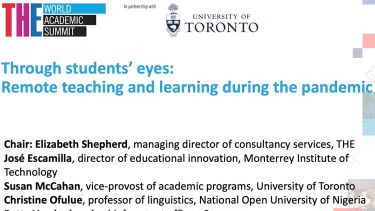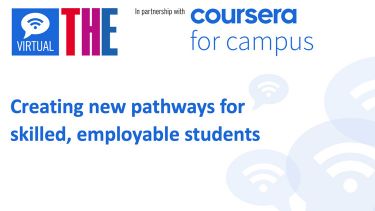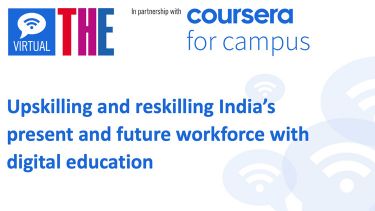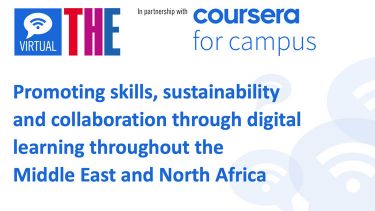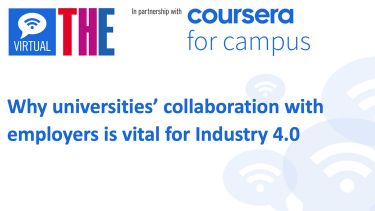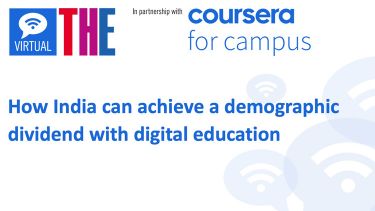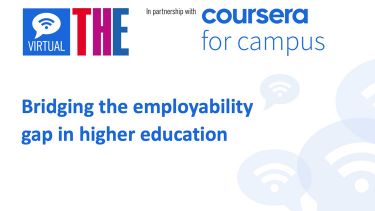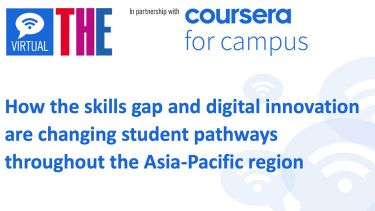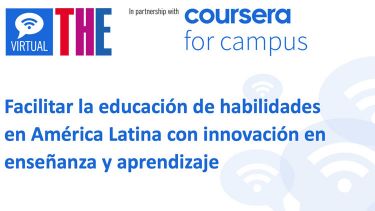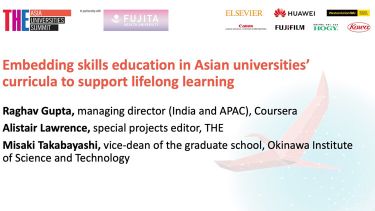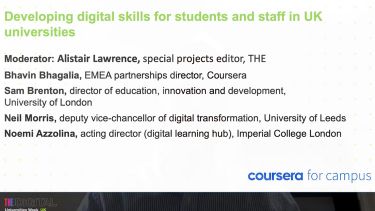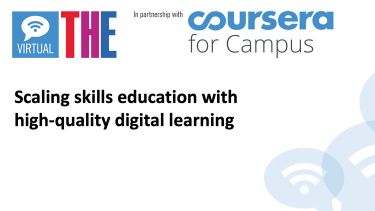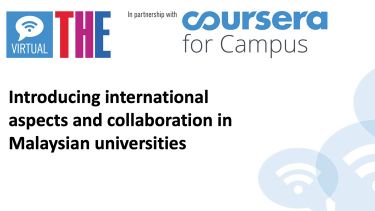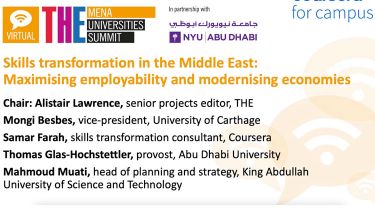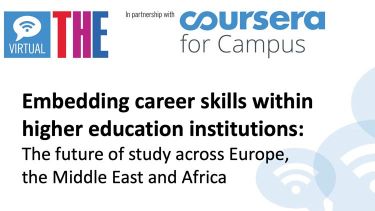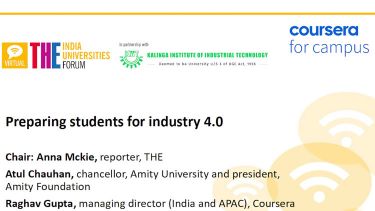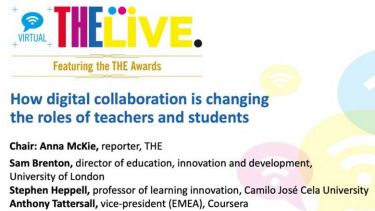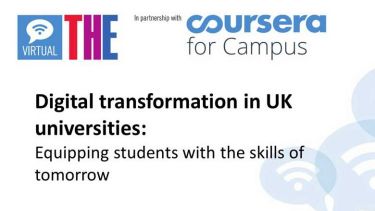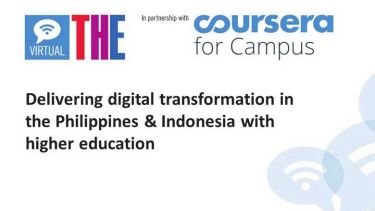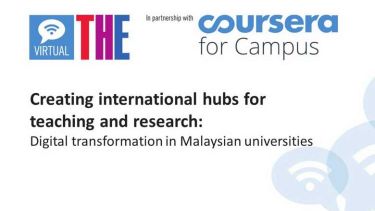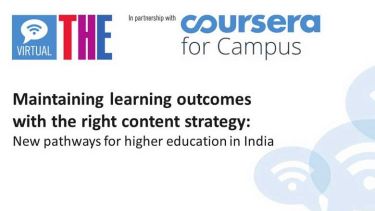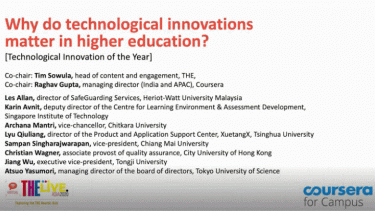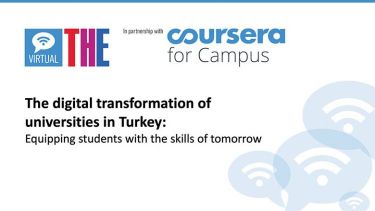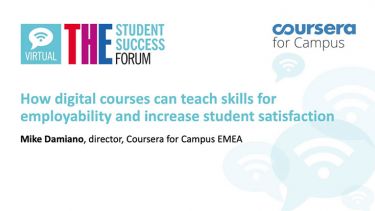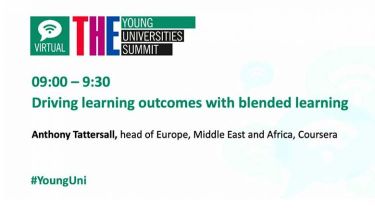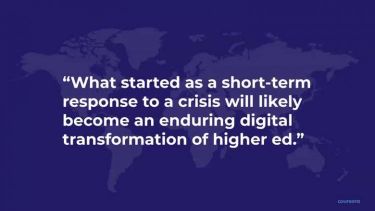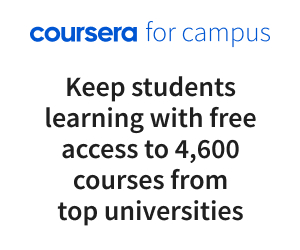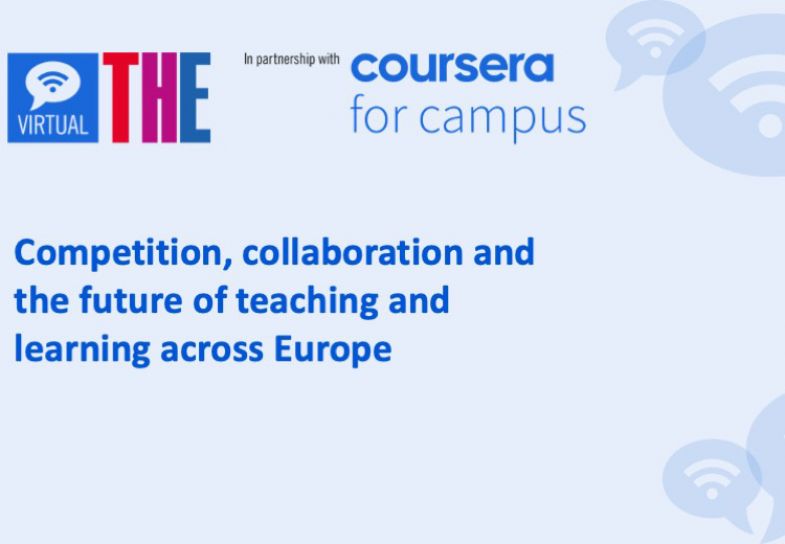
Blended learning encourages cooperation between students, teachers, businesses and other institutions
Forum held in September 2021.
The pandemic shut campuses and locked down cities, but it also prompted unprecedented collaboration in global higher education, according to speakers at the Coursera for Campus Executive Forum, titled “Competition, collaboration and the future of teaching and learning across Europe”.
Over the course of the forum, experts from academia and industry exchanged knowledge and best practice about how institutions can adapt for the future.
How to be competitive domestically and internationally: Is collaboration the secret ingredient?
At the opening session of the forum, the panellists discussed how the move online had accelerated the demand for asynchronous learning. “People could be learning at different times and yet still have the opportunity to collaborate, even with people who they normally wouldn’t be able to sit around a table with,” said Bhavin Bhagalia, Coursera’s director of partnerships for Europe, the Middle East and Africa.
Coursera’s platform has more than 82 million learners, and offers courses to over 6,000 campuses, businesses and governments.
In terms of collaboration, blended learning and online engagement have “opened up additional possibilities for things like virtual placements and virtual field trips”, said Annabel Kiernan, pro vice-chancellor at Staffordshire University in the UK. Her institution, for example, uses simulation to facilitate co-creation with industry.
This increased collaboration is not just due to the pandemic, said Aune Valk, vice-rector of academic affairs at the University of Tartu in Estonia. “At the same time, we started to see European university alliances, and that’s affecting these virtual mobility questions,” she said.
But the swift transition online encouraged greater collaboration within Valk’s university as teachers with more technological experience and skills taught those who were new to online teaching. “What we saw was cooperation within the university, not to mention the ease of inviting people from the business sector to join using online tools,” she said.
For Viorel Bostan, rector at the Technical University of Moldova, higher education’s digital transformation meant that highly regarded international academics could address his institution’s students, something that would have been more difficult and costly in the past. The same was true for conferences, which academics could now attend for a fraction of the price.
For some institutions, platforms such as Coursera were a “life jacket”, said Szakál Péter, director of academic affairs at the University of Szeged in Hungary. His university has 12 faculties, teaching more than 30,000 courses to about 20,000 students. “During the pandemic, there was an immediate need for courses,” he said.
Although many institutions are beginning to reopen their campuses, online learning platforms like Coursera are not going to disappear. They will be vital to addressing the next issue facing global institutions: scale. “By 2035, UK universities are going to require 350,000 additional spaces to cater to all the students wanting to [enter] higher education,” Coursera’s Bhagalia said. “That brings in this challenge of scale; lecture theatres will only get so big.”
The ability to teach at scale will ensure that blended teaching is here to stay, but it will be up to each organisation to determine the right balance for their institution and students, panellists agreed.
Watch the opening session of Coursera's executive forum on demand above or on the THE Connect YouTube channel.
Find out more about the session.
Optimising blended learning: What is working and what needs new models?
Universities successfully moved to delivering learning online in a matter of days during the pandemic, and plans for digital transformation accelerated overnight. “Covid-19 was a clear inflection point,” said Sevcan Turker, director of university partnerships at Coursera, introducing the session on optimising blended learning at the first breakout session of the forum.
As a new academic year begins, institutions must take stock of what worked and what didn’t, and how their blended-learning model can be adapted to best serve learners’ needs. Kirsty Kiezebrink, dean for education and innovation at the University of Aberdeen, said: “I don’t feel like universities really did blended learning last year, even if we called it that. Next year we’ll really start to see how we use classroom time in the most effective way while capturing those benefits such as not having to travel.”
Jannatul Ferdous, vice-president of welfare and equalities at London South Bank University’s Students’ Union, discussed how varied students’ experiences had been of online learning in the past year. “I’ve spoken to students who were pleased that classes were online because they do not have to commute, or found the recorded lectures handy for preparation before exams,” she said. “But there were also concerns about the money people were paying for courses that were being delivered online, and that buildings and libraries were not being used.”
The mental health impact of not meeting other students in person, as well as having to share laptop and broadband facilities with family members or flatmates also took its toll, she added.
The focus in the coming months will be on ensuring teaching quality, said Fiona Khandoker, programme manager at the Association of Commonwealth Universities. “Blended learning has been around for some time but is still new to many of us as it’s been optional,” she said. “We must support universities to redesign their content so it’s not just shifting face-to-face learning online, but is more blended overall.” Khandoker added that training a core number of academics in blended-learning pedagogy had delivered a “multiplier effect” as they passed their skills on to other staff.
Students will also need time and space to digest the experience of the past year, said Kiezebrink. “They need to reflect on what they’ve been through and what they’ve learned about themselves rather than trying to pack everything in because there’s been an education gap,” she added. Turker concluded that institutions must now concentrate on designing the best learning experiences for the medium of delivery. “We must take steps to really engage in blended learning, whether through building additional online programmes into course portfolios or using online learning to best leverage the blended experience.”
Watch this session from Coursera’s executive forum on demand above or on the THE Connect YouTube channel.
Find out more about the session.
The future of teaching and learning across Europe: What would be the main areas that you believe should be invested in?
Not only is the teaching and learning environment changing rapidly in the wake of the pandemic, students are also facing a new world of work where they may not spend every day in a physical office. A panel of higher education experts discussed higher education’s investment priorities at the forum’s second breakout session.
Evghenia Iarina, director of university partnerships for Central and Eastern Europe at Coursera, reflected on the debates around blended learning. “Like most of my colleagues, I work from home, but the classroom has largely stayed the same,” she said. “To what extent should the teaching and learning experience reflect and anticipate the workplace? Learning is a social process.”
Iván Barreda-Tarrazona, associate professor at the University Jaume I in Spain, said the past year had been an issue of survival. “We were happy with the results of online learning, but we don’t yet have feedback from employers on the Covid generation entering the labour market. We know that collaboration will be important, but finding ways to collaborate online can be a challenge.”
Lily Rumsey, director of international relations at the University of Bath, agreed that universities are yet to streamline digital collaboration. “We work with industry closely and think about the skills employers need, shaping our programmes around this. But we are yet to consider how the pandemic has changed the recruitment landscape and the fact students may not be in physical working spaces,” she said. In terms of investment priorities, she highlighted the challenges ahead for UK universities in developing a more global focus through online learning delivery.
Investment in training for staff to deliver blended learning will be crucial, said Inga Slesarenko, associate professor at Tomsk Polytechnic University in Russia. As one of the country’s leading engineering institutions, Tomsk has faced challenges in supporting students with practical learning and assessment.
“We have the technology to deliver teaching but we also need to think about software tools that can help us regulate classes where there is a cohort attending online and also a cohort in class,” Slesarenko explained. “Subjects can change in character depending on whether they’re delivered online or face to face, so we need to invest in how we deal with this.”
Collecting data about learners’ behaviour will inform future investment in tools and training, added Barreda-Tarrazona. “The applications we use are user-friendly but we need more programmes that can help us exploit the data and improve apps for students,” he said. “Otherwise, we’re operating in the dark.”
Watch this session from Coursera’s executive forum on demand above or on the THE Connect YouTube channel.
Find out more about the session.
Closing the employability gap in Europe
The Covid-19 pandemic has accelerated the automation of many jobs, but also increased the demand for employees with digital skills, Coursera’s Anthony Tattersall told the closing session of the forum.
“The challenge we’re going to face, from a global perspective, is how we help people move from those areas that are most susceptible to automation into roles where they have the opportunity to fulfil their career path and be successful in their roles,” said Tattersall, who is Coursera’s vice-president for Europe, the Middle East and Africa.
According to the World Economic Forum, companies are increasingly looking for data analysts and scientists, artificial intelligence specialists, and big data experts. “There are also lots of jobs being created, new roles that never existed,” Tattersall said.
The novelty and scarcity of these skills mean universities and employers struggle to teach them to students and employees. This is where online learning platforms such as Coursera have an important role to play.
“We have nearly 200 partners in the university space, many industry partners, and 87 million people on our platform,” Tattersall said. “Online learning that provides access to the world’s best content is a great leveller around the world. It gives equality of access to powerful content that can also help universities and institutions expand their reach to students and create learning opportunities that perhaps they could not have offered before.”
Because of its links between business, higher education and students, Coursera is also able to collect data about the skills that make people employable and how education links to economic growth. “There’s a clear correlation between the level of skills that we see within the country and the level of economic output,” Tattersall said.
However, the global digital transformation is a “leveller” and a tool to reimagine education and work. “It opens up so much more opportunity for people to have equitable access to educational outcomes,” he said. “We have an opportunity to also evolve the way that education has been delivered, recognising that the world is changing very, very fast and it’s difficult to keep up with the level of change.”
Watch the closing session of Coursera's executive forum on demand above or on the THE Connect YouTube channel.
Find out more about the session.
Find out more about Coursera for Campus.






